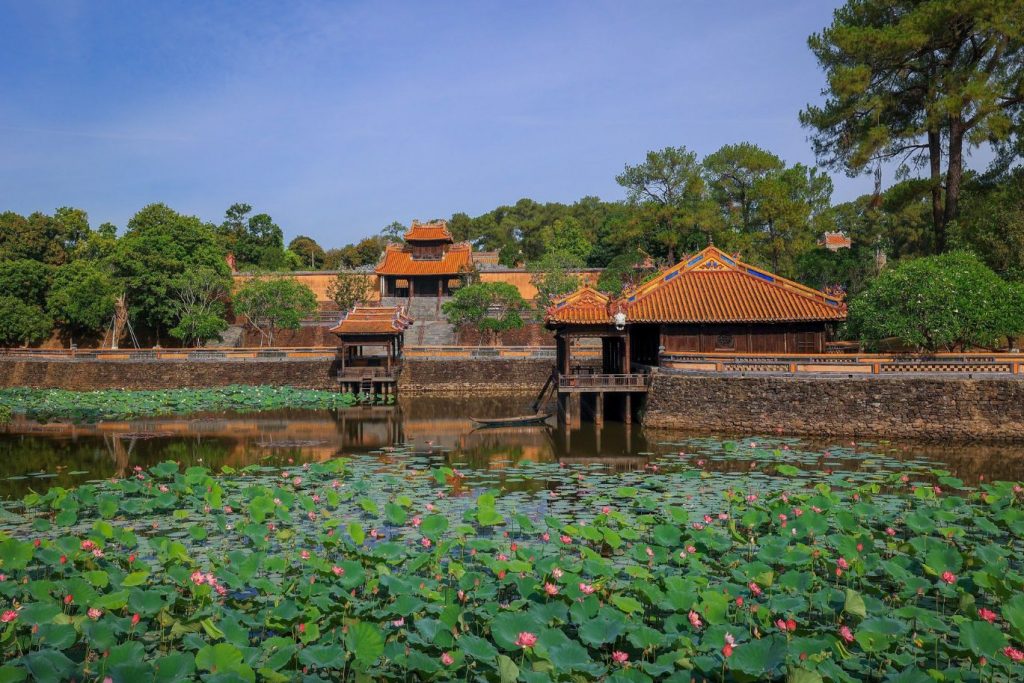
1. About Emperor Tu Duc
Emperor Tu Duc was the fourth emperor of our Nguyen Dynasty. He actually ruled for a really long time, 36 years, from 1847 to 1883, making him the longest-reigning emperor of the whole dynasty. During his time, our country faced a lot of big problems, both politically and in terms of defending the nation. That’s why historians talk about him so much. You might call him the “unlucky emperor” of the 143-year Nguyen Dynasty. He blamed himself, saying he was “unrighteous” to his brother, “unfilial” to his parents, and “incapable” of leading the country. So, what made him feel so tormented, you ask?
Emperor Tu Duc’s real name was Nguyen Phuc Hong Nham. He was the son of Emperor Thieu Tri, the third Nguyen emperor. His path to the throne was a bit unusual because, as we know, in East Asian monarchies, the eldest son usually gets the throne. But Emperor Tu Duc wasn’t the eldest son of Emperor Thieu Tri; that was Hong Bao. However, because Hong Bao just expected to inherit the throne, he didn’t bother with his studies and instead spent all his time on wild pleasures, disappointing Emperor Thieu Tri many times. On the other hand, Prince Hong Nham, even though he was the second son, was super diligent in his studies and very devoted to his father. That’s why Emperor Thieu Tri chose to pass the throne to his capable son. He believed Prince Hong Nham could manage the nation’s affairs well. Here he is!
After Emperor Thieu Tri passed away in 1847, Prince Hong Nham became emperor at just 18 years old, taking the reign title Tu Duc. And from that moment on, things at court really started to get messy. After his younger brother became emperor, Hong Bao immediately started plotting to overthrow the throne, wanting to get back what he thought was rightfully his.

Hong Bao and His Plot to Overthrow the Emperor
Hong Bao tried many times to win over the Catholics to his side, promising them not only freedom but also his influence to turn the country into a Catholic nation.
But he didn’t get any help from those offers. Then, in 1851, during the Lunar New Year, the court actually caught him as he was getting ready to sneak off to Singapore to ask for help from the British. When his plot was exposed, he wore mourning clothes, messed up his hair, and carried his child to the emperor’s palace, crying like crazy. When he finally got to see the emperor, he admitted he planned to escape abroad, but he swore it wasn’t to bring foreigners in to cause trouble. He just said he was poor, and his friends and servants were looking down on him, avoiding him… so he just wanted to go to France and live like a normal person. We’re not sure if the emperor believed all that, but he was really moved to see his older brother kneeling at his feet, begging for forgiveness. So, the emperor comforted him, promised to take care of him financially, even adopted his child, and gave him a hundred silver ingots and one gold ingot!
However, Hong Bao’s plotting didn’t stop there. In 1854, he tried again, teaming up with his buddies to stage another coup to overthrow his younger brother. And once again, the plot was found out. Hong Bao was arrested and put in prison; not long after, he committed suicide there.
Because of this sad family tragedy, Emperor Tu Duc often blamed himself for being “unrighteous,” believing he had pushed his own flesh and blood to such a desperate end.
Emperor Tu Duc and the Pain of Foreign Invasion
In 1858, Vietnam faced a super important historical turning point. The French and Spanish forces teamed up and attacked Da Nang Bay, starting their invasion of Vietnam. At first, we managed to hold off the French in Da Nang pretty well. But then, in 1859, the French pushed into Gia Dinh in Southern Vietnam. The South quickly fell, and that’s when the Nguyen Dynasty started going through some really dark times in our nation’s history.
The huge difference in military weapons and army strength meant our court kept losing battles, from the South all the way to the North. Throughout Emperor Tu Duc’s reign, he had to sign three treaties, with tons of negotiations, all to get what the French called “peace.” In the end, six southern provinces and several other powers of the court were just taken away from us.
2. The Khiem Lang's name story
The “Chay Voi” (Pestle) Rebellion
In 1864, Emperor Tu Duc started building Khiem Cung (which would actually become his tomb after he passed away). He wanted it as a place to relax from all the stressful government work and to escape the stuffy imperial palace.
But, like smouldering embers waiting to burst into flames again, in 1866, some people saw how tough and difficult the Khiem Cung construction was. So, Doan Huu Trung, along with some folks from Prince Hong Bao’s old group, used the excuse of putting Dinh Dao (Hong Bao’s son) on the throne and launched a coup.
They actually used “chày vôi” (lime pestles) – you know, just normal tools – as weapons and marched into the imperial palace in the middle of the night. Their goal was to force Emperor Tu Duc to give up his throne to his nephew. The rebellion got all the way to the palace gates. Just when it seemed like it was all over for Emperor Tu Duc, his Imperial Guard counter-attacked and successfully put down the rebellion. The coup failed, and Doan Huu Trung and his two younger brothers were killed at only 22 years old. As for Dinh Dao, his mother, wife, son, and daughter – eight people in total – were all strangled right away. So, Hong Bao’s family line ended there. Emperor Tu Duc was once again caught in this terrible “kin slaying kin” situation, which made him even more sad and depressed about his own fate.
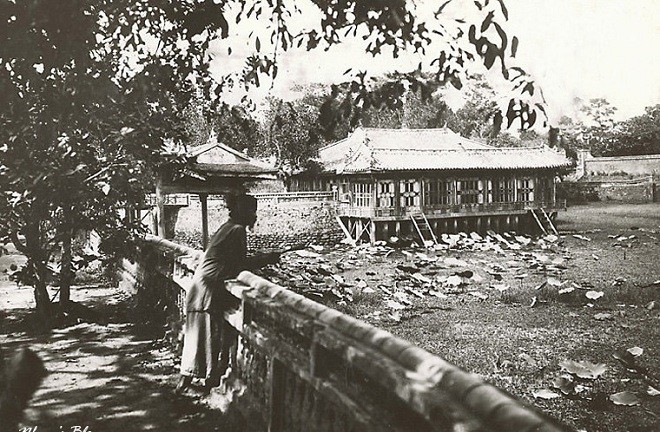
Khiem Cung and What’s Inside?
After three years of building, Khiem Cung was finished in 1867. It pretty much became the emperor’s second palace. Khiem Cung has this really special thing that’s hard to find anywhere else: almost every building here has the word “Khiem” in its name. “Khiem” means humility, respect, yielding, and so on. Emperor Tu Duc used this word to name his palace as a constant reminder to himself to always be humble and to reflect on himself in every situation.
When you go through Vu Khiem Gate (the main gate of the tomb), the first thing you see on the right is Luu Khiem Lake. This was originally a small stream in the tomb area that they dug out to make this lake. In the middle of the lake, there’s Tinh Khiem Island. On Luu Khiem Lake, you’ll find Xung Khiem Ta and Du Khiem Ta, where the emperor used to come to admire flowers, write poetry, and read books. These natural scenes make you completely forget that this is a tomb for someone who’s passed away. You just feel like you’re surrounded by the scent of plants and the sound of flowing water – it’s really poetic!
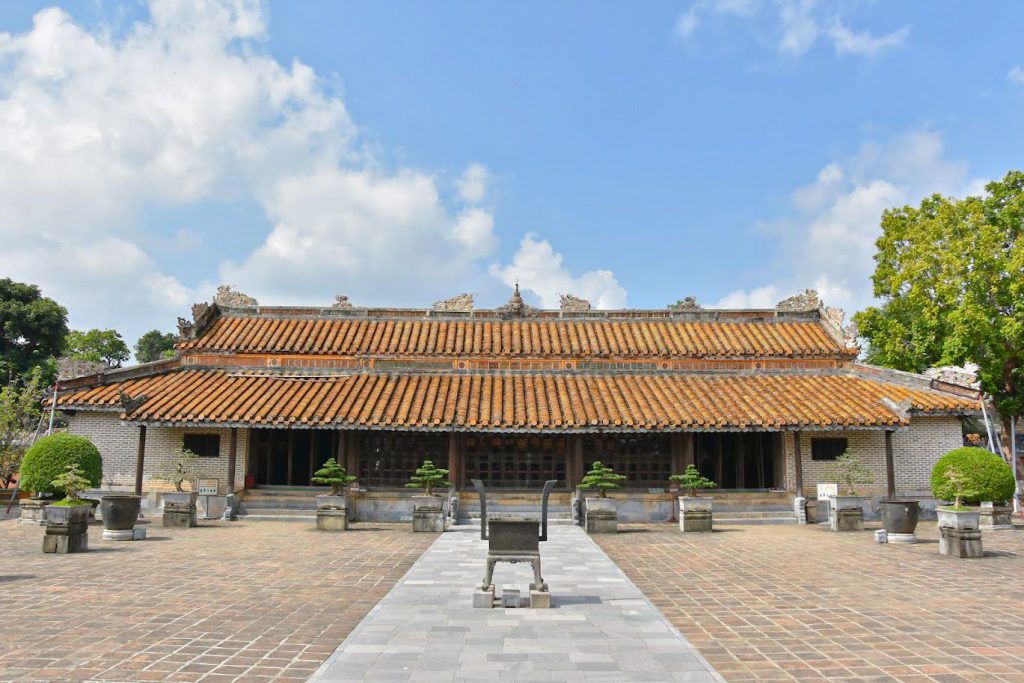
The Temple Area
Right across from Luu Khiem Lake is the front of Khiem Cung Mon – it’s a two-story building that looks like a watchtower. Inside Khiem Cung Mon is where the emperor would relax whenever he visited. Right in the middle is Hoa Khiem Palace, where the emperor used to work. Nowadays, it’s where they worship the ancestral tablets of the emperor and empress. On the left and right sides are Phap Khiem Vu and Le Khiem Vu, for the civil and military mandarins who came along with him. Behind Hoa Khiem Palace is Luong Khiem Palace. This used to be the emperor’s resting place, but later it was used to worship the spirit of Empress Dowager Tu Du, Emperor Tu Duc’s mother. To the right of Luong Khiem Palace is On Khiem Palace. This place was originally for storing imperial items, but later it became the residence of Empress Le Thien Anh (Emperor Tu Duc’s wife) until she passed away. And get this, to the left of Luong Khiem Palace, there’s the Minh Khiem Theatre, where the emperor watched performances. It’s considered one of Vietnam’s oldest surviving theatres!
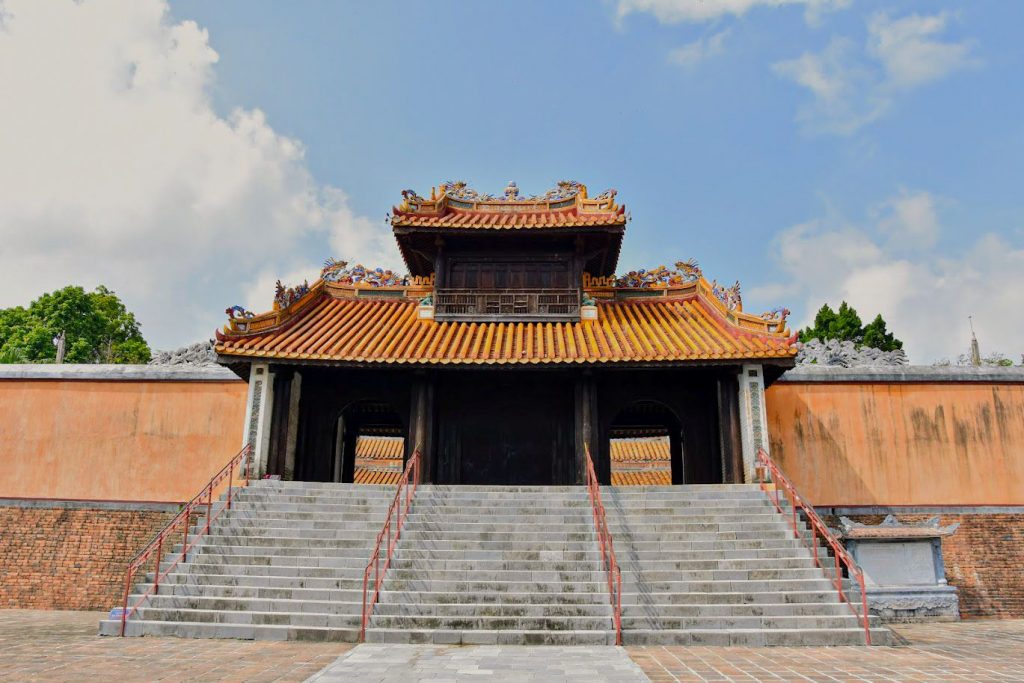
The Harem/Rear Palace Area
There’s a corridor from On Khiem Palace that leads to Tri Khiem Vien and Y Khiem Vien, which were the living quarters for the concubines who served the emperor. Nearby, you’ll find Tung Khiem Vien, Dung Khiem Vien, and the emperor’s deer park.
Also in this area, there’s a very special building called Chi Khiem Duong. This is where incense is offered to the concubines of previous dynasties and also to Emperor Tu Duc’s concubines after they passed away.
Adding another sad note to the emperor’s life, he didn’t have any direct heirs, or to be more precise, no biological children. Because of complications from smallpox when he was a child, his health was weakened, which led to infertility. And according to ancient beliefs, “bất hiếu hữu tam, vô hậu vi đại,” meaning that among the three unfilial acts, not having an heir is the biggest sin. For this reason, the emperor felt even more grief and blamed himself for being unfilial, even though, in reality, he was famous for being a very filial emperor of the Nguyen Dynasty.
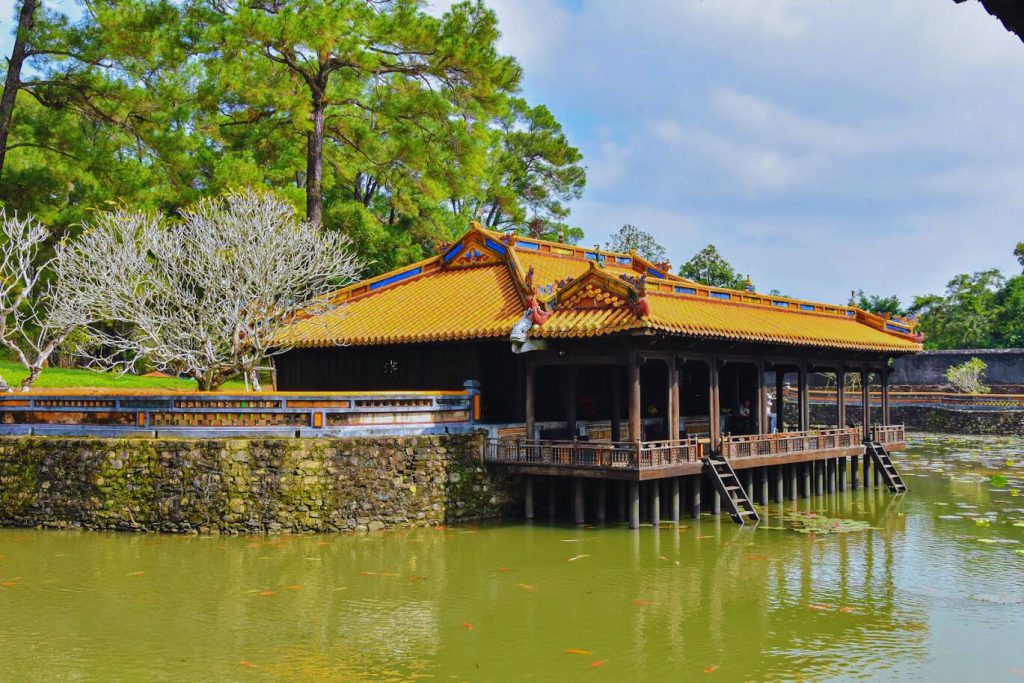
The Tomb Section
If you follow the path towards the source of Luu Khiem Lake, you’ll get to the emperor’s tomb area. From the outside, you first see the Bai Dinh Courtyard with two rows of stone statues. They depict a grand court scene with civil and military mandarins, bodyguards, horses, and elephants.
Next up is the Bi Dinh (Stele Pavilion). Now, in other emperors’ tombs, the Bi Dinh usually holds the Thanh Duc Than Cong stone stele, written by the emperor’s own biological son. But, as we know, Emperor Tu Duc didn’t have any biological children. So, he actually wrote this stele inscription himself and named it Khiem Cung Ky.
The Khiem Cung Ky text has five sections. It talks about building Emperor Tu Duc’s tomb, describes the scenery inside the tomb, the emperor’s feelings for the country, and his personal life. The first section is about his childhood. The second is about when he took on the country’s responsibilities. The third describes Khiem Lang (Emperor Tu Duc’s tomb) and its buildings, plus what they were used for back then and what they’d be used for later. The fourth section shares the emperor’s thoughts and simple wishes. And the fifth section is where the emperor clearly explains what the Khiem Cung Ky is all about – it’s a text showing his feelings, recording what he did, his mistakes, and his heartfelt confessions.
In the Bi Dinh area, you’ll see two Hoa Bieu pillars on either side. These are pretty special because you only find them at the resting places of emperors and empresses. These two Hoa Bieu pillars are like landmarks telling you that you’re about to enter the emperor’s final resting place, so you should be careful with what you say and show your respect.
Next, you’ll see a small, crescent-shaped pond, and beyond that is Buu Thanh, which is where the emperor’s body is placed.
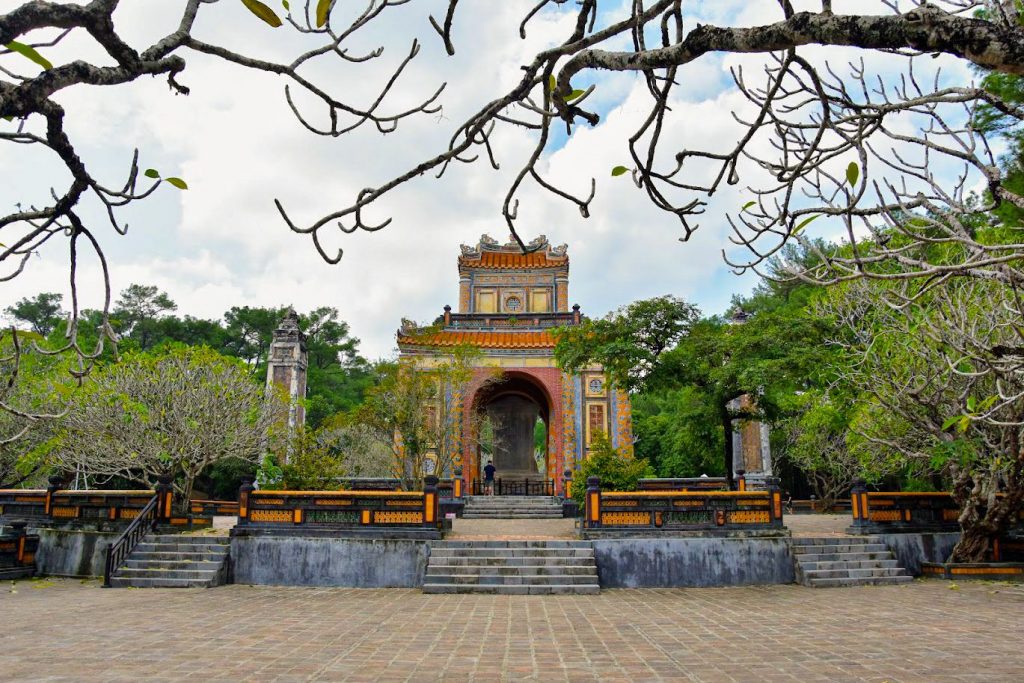
Nearby Structures
Within the Khiem Lang complex, there are also two other tombs for some equally important people. One is Khiem Tho Lang for Empress Le Thien Anh, the emperor’s main wife. And the other is Boi Lang for Emperor Kien Phuc, who was the emperor’s adopted son. He’s connected to that famous historical period called “Four Months, Three Emperors” of the Nguyen Dynasty (that’s when
So, Emperor Tu Duc’s Tomb – Khiem Lang – isn’t just a beautiful, poetic place. It also hides all these stories of a dynasty and a really sad time our country went through. But what I’ve told you today isn’t even all the stories about this fourth emperor’s reign! What about the story of his devotion to his mother? What kind of historical upheaval was “Four Months, Three Emperors” that made kings take the throne one after another so quickly? And what’s the story of the empress who was given her title by her younger brother? Join our tour to find out more about these fascinating tales!


